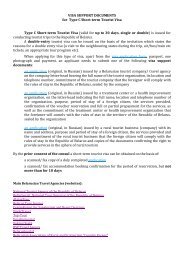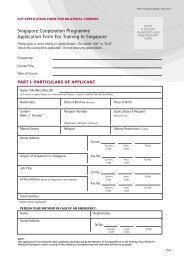Human Development Report 2013 - UNDP
Human Development Report 2013 - UNDP
Human Development Report 2013 - UNDP
Create successful ePaper yourself
Turn your PDF publications into a flip-book with our unique Google optimized e-Paper software.
As countries develop,they tend to dismantletrade barriers andbecome more openriver by feeling the stones”. 49 Between 1979and 1989, no fewer than 40% of China’snational regulations were deemed experimental.The first set of agrarian reforms permittedfarmers to lease land, submit a shareof produce at fixed prices to the state andsell the surplus. Next came the expansion ofthe township and village enterprises. 50 Thegradual approach reflected the pragmatismof Chinese leaders. Another reason for thispragmatism was the perception that thetransition was impossible to plan, compoundedby disillusionment with the wholeplanning system.Driver 2: tapping of global marketsA common element of the fast-developingcountries of the South has been to strengthenthe capabilities of people and the competenciesof firms while embracing global markets.This has enabled them to source intermediateinputs and capital goods at competitive worldprices, adopt foreign knowhow and technologyand use them to sell to global markets. 51 Allnewly industrializing countries have pursueda strategy of “importing what the rest of theworld knows and exporting what it wants”. 52Indeed, few countries have developed successfullyby shunning international trade or longtermcapital flows; very few have sustainedgrowth without increasing their trade to outputratio, and there is no evidence that in the postwarperiod inward-looking economies havesystematically developed faster than those thathave been more open. 53This experience does not mean, however,that countries can ignite growth simply bydismantling trade and investment barriers.Some influential cross-national studies in the1990s purported to show that rapidly openingup would automatically lead to high economicgrowth. But these were subsequently found tohave significant methodological limitations. 54In particular, growth cannot be sufficientlyexplained by average tariff and nontariffbarriers. 55Actual development experiences from theSouth have demonstrated a more nuancedconsensus. 56 In this view, successful and sustainedprogress is more likely to be the resultof gradual and sequenced integration withthe world economy, according to national circumstances,and accompanied by investmentin people, institutions and infrastructure. 57Country studies confirm that what is neededis a package that involves the interaction ofreforms in trade, exchange rates, and fiscal,monetary and institutional policies. 58 A recentstudy finds that more decisive benefitscome from trade liberalization embedded inbroader reforms: in the post-liberalizationperiod between 1950 and 1998, the countriesthat were considered to have implementedsuch policies posted growth rates that were1.5 percentage points higher, investment ratesthat were 1.5–2 percentage points higher andtrade to output ratios that were 5 percentagepoints higher. 59As countries develop, they tend to dismantletrade barriers and become more open. 60HDRO analysis of the association betweenthe change in trade openness and relative improvementin HDI value between 1990 and2010 supports this conclusion (see box 2.1 inchapter 2). Not all countries that increasedtrade openness made big improvements inHDI value relative to their peers. But thosethat did make big improvements in HDI valuetypically increased their trade to output ratioor established a global network of trade linksof substantial bilateral value. In a sample of 95developing countries and transitional economies,the average increase in trade to output ratioof countries considered to be rapid improverson the HDI between 1990 and 2012 was about13 percentage points higher than that of moremodest improvers.As discussed in box 2.1 in chapter 2, almostall countries with substantial improvement inHDI value over the past two decades have alsobecome more integrated with the world economy.Table 3.2 reconfirms this for a selectedgroup of high human development–achievingcountries discussed in this chapter, which havevigorously tapped opportunities presented byglobalization by expanding their share of exportsin world markets between 1990 and 2010.The only exception in this group is Mauritius,one of the first countries in the South to pursuean export-oriented development strategy,whose share in world exports peaked in 2001. 61As the more populous countries deepen their74 | HUMAN DEVELOPMENT REPORT <strong>2013</strong>
















